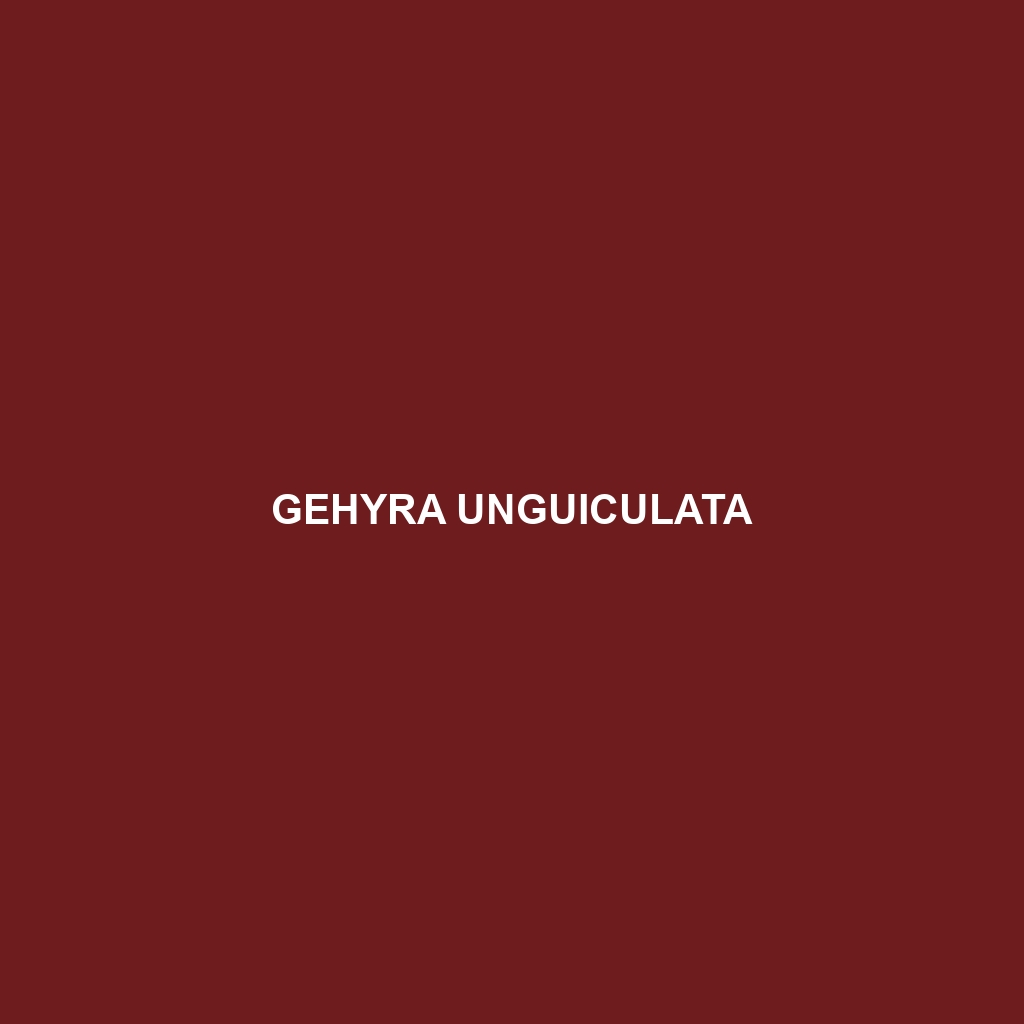Common Name
Gehyra unguiculata
Scientific Name
Gehyra unguiculata
Habitat
Gehyra unguiculata, commonly known as the Centralian rough knob-tail gecko, primarily inhabits various environments within central Australia. This species is predominantly found in rocky outcrops, arid woodlands, and open savannas, thriving in regions that experience a temperate climate. Its preferred habitats are characterized by ample shelters, such as crevices and shaded areas, where it can hide from predators and regulate its body temperature. The gecko is less frequently found in dense rainforests or marine habitats, showcasing a preference for dry and semi-arid ecosystems.
Physical Characteristics
Physically, Gehyra unguiculata measures approximately 12 to 20 centimeters in total length. One of its most distinctive features is its broad, flattened body adorned with heterogeneous spotting and banding patterns that vary among individuals. The coloration typically ranges from light brown to grey, providing excellent camouflage against the rocky landscapes it inhabits. The gecko’s tail is particularly noteworthy for its stout, knob-like appearance, which serves as a defense mechanism—when threatened, it may drop its tail to evade predators. Its limbs are robust, equipped with adhesive pads that enhance its climbing abilities on vertical surfaces.
Behavior
Gehyra unguiculata exhibits intriguing nocturnal behavior, being most active during the night. This adaptation facilitates hunting and avoiding daytime predators. Socially, these geckos are known to demonstrate territorial behaviors, especially during the breeding season, where males engage in displays of dominance that can include head-bobbing and push-up motions. Their mating rituals are captivating; after engaging in a series of courtship behaviors, females lay clutches of eggs which they bury for warmth and protection. The Centralian rough knob-tail gecko has also earned a reputation for its unique vocalizations, often using soft sounds during social interactions.
Diet
The diet of Gehyra unguiculata is primarily insectivorous, with a keen preference for a variety of insects such as crickets, beetles, and moths. Occasionally, they may consume small invertebrates, exhibiting opportunistic feeding behaviors that align with their nocturnal predation. With a highly developed sense of sight, this gecko is adept at spotting prey in low-light conditions, feeding primarily on the surface of soils and vegetation where insects are abundant. As a predator, it plays a crucial role in controlling insect populations within its habitat.
Reproduction
The reproductive cycle of Gehyra unguiculata primarily occurs during the warmer months, usually between September and February. Males will engage in elaborate courtship displays to attract females. Following successful mating, the female typically lays one to two eggs, which she buries in sandy or loose soil to protect them from environmental hazards. The incubation period ranges from approximately 45 to 60 days, after which the hatchlings emerge, fully formed and ready to fend for themselves. Parental care is minimal, with females often abandoning the nesting site shortly after laying eggs.
Conservation Status
The conservation status of Gehyra unguiculata currently stands at Least Concern, according to the International Union for Conservation of Nature (IUCN). This species is not facing immediate threats; however, habitat destruction and climate change pose potential risks. Conservation efforts are focused on habitat preservation and monitoring populations to ensure any emerging threats are promptly addressed. Continuous research is important to track the effects of environmental changes on their habitats.
Interesting Facts
One fascinating aspect of Gehyra unguiculata is its ability to adapt to various microhabitats. These geckos exhibit remarkable skill in climbing and often utilize arboreal habitats for hunting and shelter. They are also known for their impressive camouflage, which allows them to evade predators effectively. Additionally, their unique tail serves not only in defense but also in fat storage, an essential adaptation for survival in arid climates.
Role in Ecosystem
Gehyra unguiculata plays a significant role in its ecosystem as a predator and prey species. As an insectivore, it assists in regulating insect populations, which helps to maintain ecological balance. Moreover, as a part of the food web, it serves as prey for larger predators, contributing to the biodiversity of the habitats in which it resides. While not classified as a keystone species, the Centralian rough knob-tail gecko’s presence is indicative of a healthy ecosystem, as it thrives in stable environments. Its interactions with both prey and predator species highlight its integral role in the survival of the ecological community.
